Studienarbeit zum Thema: Perceptron Problem in Neural Network. Informatik - Theoretische Inf. auf englisch.
Inhaltsverzeichnis (Table of Contents)
- Perceptron Problem
- Data Distribution
- Weight Vector Update
- Region of Final Weight Vector
- Optimum Connection Weight
- Direction of Adjustment
- Input Potential
- Initial Weight Vector
- Weight Vector Rotation
- Weight Vector No Adjustment
Zielsetzung und Themenschwerpunkte (Objectives and Key Themes)
This document aims to analyze the behavior of a perceptron, a fundamental element in neural networks, when confronted with specific input data distribution patterns. It explores the impact of input data on the weight vector's update and its final position.
- Perceptron behavior under different input data distributions
- Impact of input data on weight vector update
- Determination of the final weight vector's location
- Identification of the optimum connection weight
- Understanding the direction of weight vector adjustments
Zusammenfassung der Kapitel (Chapter Summaries)
- Perceptron Problem: Introduces the perceptron model, its input data, and the relationship between input and output. The document focuses on a perceptron with two-dimensional input data and a binary output.
- Data Distribution: Describes the specific distribution of input data for two classes (C1 and C2) within a defined angular range. The initial connection weight vector is also introduced.
- Weight Vector Update: Presents the formulas for updating the weight vector based on input data and error calculation. It clarifies the role of the learning rate (n) in this process.
- Region of Final Weight Vector: Explores the regions where the final weight vector can locate depending on the value of the learning rate (n). It examines both large and very small learning rates.
- Optimum Connection Weight: Discusses the determination of the optimum connection weight, aiming to maximize the perceptron's performance in classifying the input data.
- Direction of Adjustment: Explains the direction of adjustment for the weight vector based on input data, particularly when the input data belongs to class C2.
- Input Potential: Presents the equation for calculating the input potential, which relates to the angle between the weight vector and the input vector.
- Initial Weight Vector: Sets the initial weight vector and describes its initial angle in relation to the input data.
- Weight Vector Rotation: Analyzes the counterclockwise rotation of the weight vector when input data from class C2 falls within a specific angular range (270-340 degrees).
- Weight Vector No Adjustment: Demonstrates that the weight vector remains unchanged when input data from class C2 falls within another specific angular range (225-270 degrees).
Schlüsselwörter (Keywords)
This document focuses on key concepts related to the perceptron model, including input data distribution, weight vector update, learning rate, optimum connection weight, and weight vector adjustment. The document examines these concepts in the context of specific angular ranges of input data, highlighting the relationship between input data and weight vector behavior.
- Arbeit zitieren
- Dang Xuan Tho (Autor:in), 2010, Perceptron Problem in Neural Network, München, GRIN Verlag, https://www.hausarbeiten.de/document/153037


